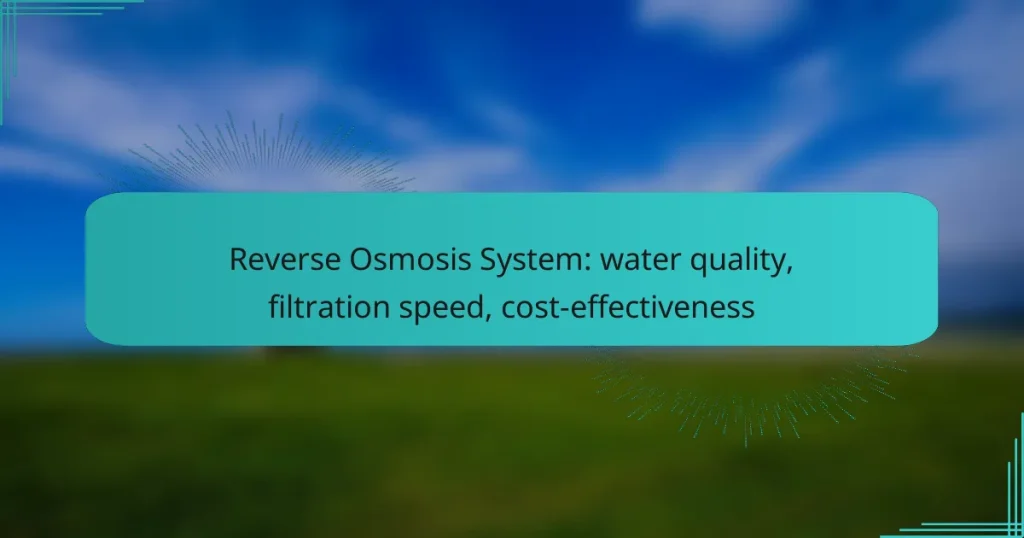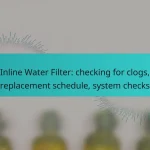A Reverse Osmosis (RO) system significantly enhances water quality by effectively removing impurities and contaminants, ensuring cleaner and safer drinking water. With filtration speeds that can reach several gallons per hour, these systems provide quick access to purified water for various uses. Although the initial investment may be substantial, the long-term cost-effectiveness and savings on bottled water make RO systems a worthwhile choice for many households.

How does a Reverse Osmosis System improve water quality in the UK?
A Reverse Osmosis (RO) system significantly enhances water quality in the UK by effectively removing impurities and contaminants. This filtration method ensures that the water you consume is cleaner, safer, and more palatable.
Removes contaminants
Reverse Osmosis systems are designed to eliminate a wide range of contaminants, including heavy metals, chlorine, and bacteria. The semi-permeable membrane used in these systems allows only water molecules to pass through while blocking larger particles and harmful substances.
In the UK, common contaminants such as lead and nitrates can be effectively filtered out, ensuring that the water meets safety standards. Regular maintenance and membrane replacement are essential to maintain optimal performance and ensure continued contaminant removal.
Enhances taste
By removing impurities, Reverse Osmosis systems greatly improve the taste of drinking water. Many users report that RO-treated water tastes fresher and cleaner compared to tap water, which may contain chlorine or other taste-altering chemicals.
This enhancement in taste can encourage more water consumption, contributing to better hydration. For households with sensitive palates, investing in an RO system can make a noticeable difference in daily drinking experiences.
Reduces hardness
Hard water, which contains high levels of calcium and magnesium, can lead to scale buildup in pipes and appliances. Reverse Osmosis systems can help reduce water hardness, making it gentler on plumbing and appliances.
In the UK, where hard water is prevalent in certain regions, using an RO system can prolong the lifespan of water heaters and reduce the need for descaling products. This not only saves money but also enhances the overall efficiency of water usage in the home.

What is the filtration speed of Reverse Osmosis Systems?
The filtration speed of reverse osmosis systems typically ranges from a few gallons to several gallons per hour, depending on the system’s design and capacity. This speed is crucial for determining how quickly you can obtain purified water for drinking and other uses.
Typical filtration rates
Most residential reverse osmosis systems have filtration rates between 50 to 100 gallons per day. Higher-capacity systems can produce up to 300 gallons per day, making them suitable for larger households or commercial applications. Understanding these rates helps in selecting a system that meets your daily water needs.
Factors affecting speed
Several factors influence the filtration speed of reverse osmosis systems, including water pressure, temperature, and the quality of the incoming water. Higher water pressure generally increases the filtration rate, while lower temperatures can slow it down significantly.
The type and condition of the membrane also play a critical role. A new, high-quality membrane will filter water faster than an older or clogged one. Regular maintenance and timely replacement of filters can help maintain optimal filtration speeds.

What is the cost-effectiveness of Reverse Osmosis Systems?
Reverse osmosis systems can be highly cost-effective over time, especially when considering their long-term benefits. While the initial investment may seem significant, the savings on water quality and reduced reliance on bottled water often outweigh these costs.
Initial investment analysis
The initial cost of a reverse osmosis system typically ranges from a few hundred to over a thousand USD, depending on the system’s capacity and features. Installation costs may also apply, which can vary based on local labor rates and plumbing requirements.
When evaluating the investment, consider factors such as the system’s lifespan, maintenance needs, and warranty. A well-maintained system can last several years, making the upfront cost more manageable over time.
Long-term savings on bottled water
Investing in a reverse osmosis system can lead to substantial savings on bottled water. Households that regularly purchase bottled water may spend hundreds to thousands of USD annually, depending on consumption levels.
With a reverse osmosis system, the cost per gallon of purified water is significantly lower, often just a few cents. This not only reduces expenses but also minimizes environmental impact by decreasing plastic waste from bottled water.
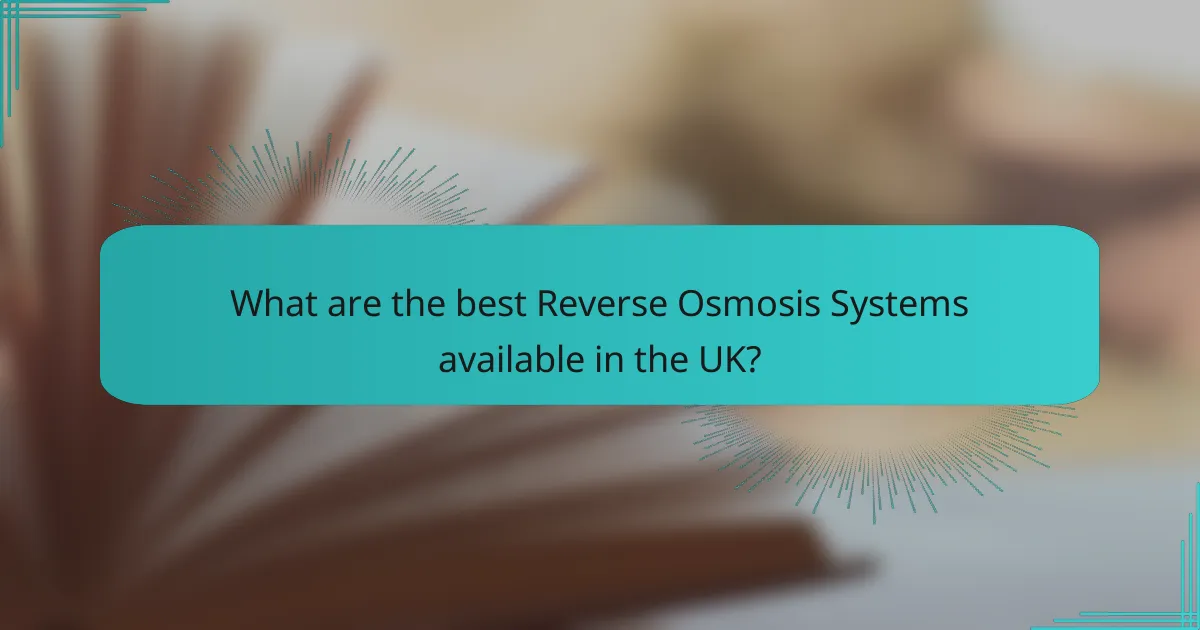
What are the best Reverse Osmosis Systems available in the UK?
The best reverse osmosis systems in the UK are those that effectively improve water quality, offer efficient filtration speed, and provide cost-effective solutions. Popular options include systems that meet UK water quality standards and are designed for both residential and commercial use.
Top-rated brands
Some of the top-rated reverse osmosis brands in the UK include APEC, AquaFX, and iSpring. These brands are known for their reliability, high filtration performance, and customer satisfaction. Many of their systems come with multiple stages of filtration, ensuring contaminants are effectively removed.
Another notable brand is Waterdrop, which offers compact designs suitable for smaller spaces without compromising on filtration quality. Each brand typically provides various models to cater to different needs and budgets.
Comparison of features
When comparing reverse osmosis systems, consider factors such as filtration speed, number of stages, and maintenance requirements. Most systems operate at filtration speeds ranging from 50 to 100 gallons per day, depending on the model and water pressure.
Key features to look for include the type of filters used, ease of installation, and whether the system has a storage tank. Systems with more filtration stages often provide better water quality but may require more frequent filter changes. It’s essential to balance performance with ongoing costs to ensure overall cost-effectiveness.
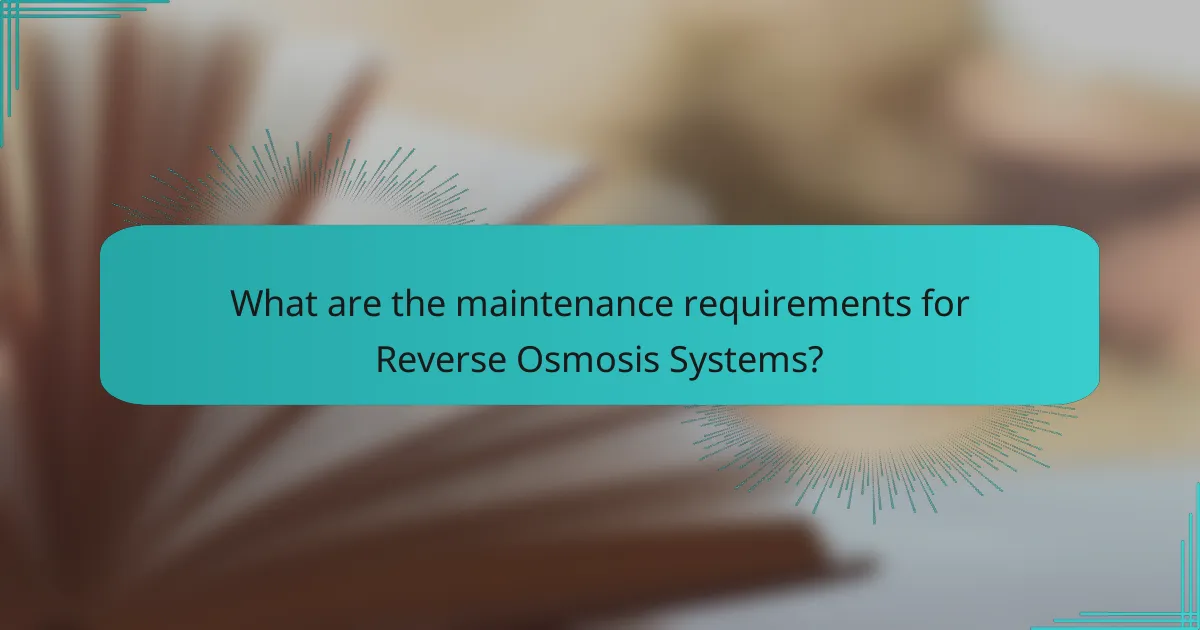
What are the maintenance requirements for Reverse Osmosis Systems?
Reverse osmosis systems require regular maintenance to ensure optimal performance and water quality. Key tasks include replacing filters and cleaning components to prevent buildup and inefficiency.
Filter replacement schedule
Filters in a reverse osmosis system typically need replacement every 6 to 12 months, depending on usage and water quality. Pre-filters and post-filters often require more frequent changes than the membrane itself, which can last 2 to 5 years.
To determine the right schedule, monitor water production and taste. If you notice a decrease in flow rate or a change in taste or odor, it may be time to replace the filters sooner.
Cleaning procedures
Cleaning the reverse osmosis system is essential to maintain its efficiency. Regularly inspect and clean the storage tank and the faucet to prevent bacterial growth and mineral buildup.
Use a mild vinegar solution or a specialized cleaning solution recommended by the manufacturer. Follow the instructions carefully, and consider cleaning the system every 6 months to a year, or as needed based on water quality.
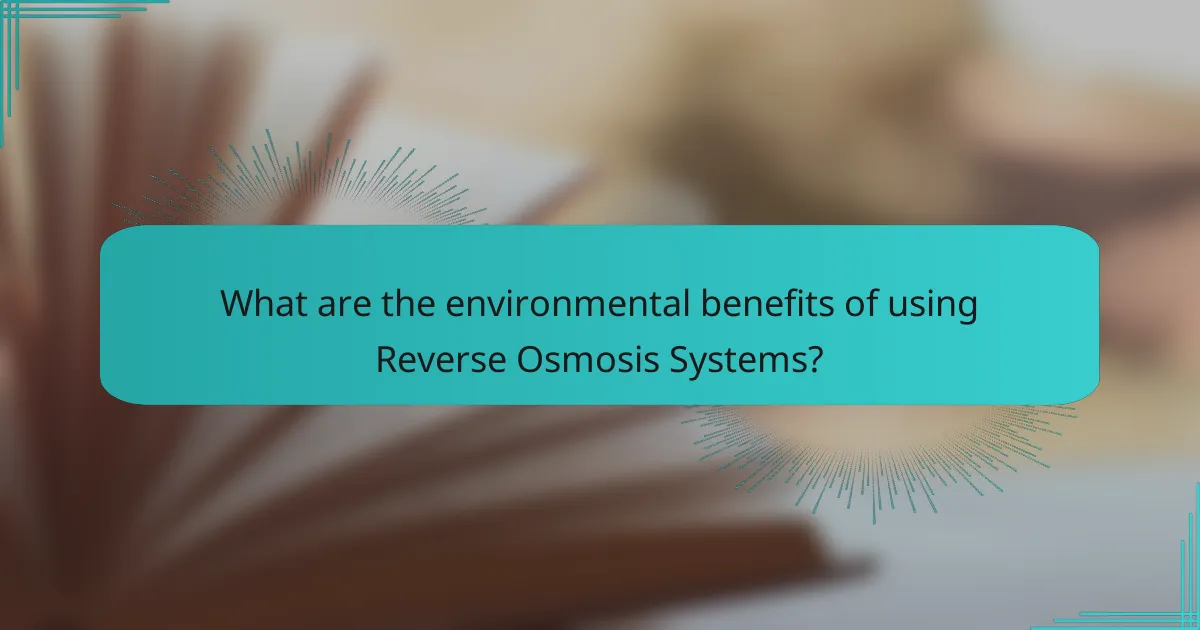
What are the environmental benefits of using Reverse Osmosis Systems?
Reverse Osmosis (RO) systems offer significant environmental benefits by improving water quality and reducing reliance on bottled water. These systems effectively filter contaminants from water, leading to cleaner drinking water and less plastic waste.
Reduction in plastic waste
Using Reverse Osmosis systems can greatly decrease the demand for bottled water, which is a major contributor to plastic pollution. By providing a reliable source of purified water at home, consumers can reduce their reliance on single-use plastic bottles.
For instance, a household that shifts from purchasing bottled water to using an RO system can prevent hundreds of plastic bottles from entering landfills each year. This shift not only conserves resources but also minimizes the carbon footprint associated with plastic production and transportation.
Water conservation benefits
Reverse Osmosis systems can contribute to water conservation by ensuring that water is used more efficiently. These systems filter out impurities, allowing households to use tap water for drinking and cooking without the need for additional bottled water.
Moreover, many RO systems are designed to minimize waste water, with some models producing only a small fraction of waste compared to the purified water they generate. This efficiency can lead to significant water savings, especially in areas where water resources are limited.

How to choose the right Reverse Osmosis System for your home?
Choosing the right reverse osmosis system for your home involves evaluating water quality, filtration speed, and cost-effectiveness. Consider your specific water needs and budget to find a system that balances these factors effectively.
Key selection criteria
When selecting a reverse osmosis system, focus on water quality, filtration speed, and maintenance requirements. Assess the contaminants in your water supply, as some systems target specific impurities better than others. Look for systems with a filtration speed that meets your household’s daily water consumption, typically ranging from 50 to 100 gallons per day.
Cost-effectiveness is another critical factor. Evaluate the initial purchase price, installation costs, and ongoing maintenance expenses, including filter replacements. Systems can vary widely in price, from a few hundred to over a thousand dollars, depending on features and capacity.
Local installation options
Research local installation options to ensure you have access to qualified technicians. Many home improvement stores and plumbing services offer installation for reverse osmosis systems, often providing warranties and support. Check for local regulations regarding water filtration systems, as some areas may have specific requirements.
Consider seeking recommendations from neighbors or online reviews to find reliable installation services. Getting multiple quotes can help you compare prices and services, ensuring you choose a reputable installer who understands local water quality issues.

What are common misconceptions about Reverse Osmosis Systems?
Many people misunderstand reverse osmosis systems, believing they are ineffective or harmful. Common misconceptions include the idea that these systems remove essential minerals from water and that they are too slow or expensive for practical use.
Myth: Removes essential minerals
One prevalent myth is that reverse osmosis (RO) systems strip water of essential minerals. While it’s true that RO systems can remove a wide range of contaminants, including some beneficial minerals, the impact on overall mineral intake is minimal for most people.
Minerals like calcium and magnesium are often obtained from food rather than water. If you rely on RO water, consider supplementing your diet with mineral-rich foods or using remineralization filters that can add back beneficial minerals after filtration.
Myth: Too slow for practical use
Another misconception is that reverse osmosis systems are too slow to provide adequate water supply. While traditional RO systems may have a slower output compared to other filtration methods, modern systems can produce water at rates that meet typical household needs.
Myth: Costly and not cost-effective
Some believe that reverse osmosis systems are too expensive and not worth the investment. While the initial cost can be higher than other filtration options, RO systems can save money over time by reducing the need for bottled water and minimizing plumbing issues caused by contaminants.
Consider the long-term savings and health benefits when evaluating the cost. Many systems also have low maintenance costs, making them a cost-effective solution for clean drinking water in the long run.
